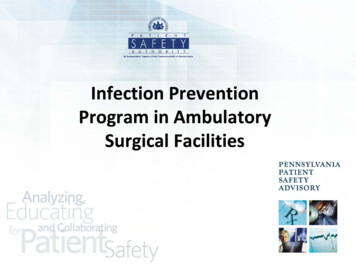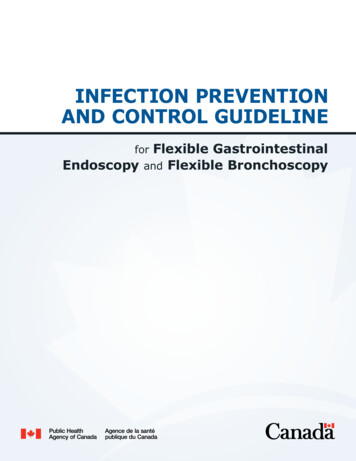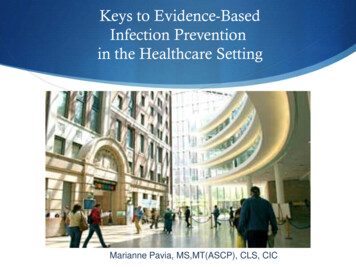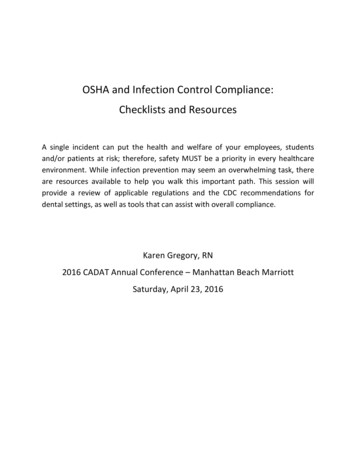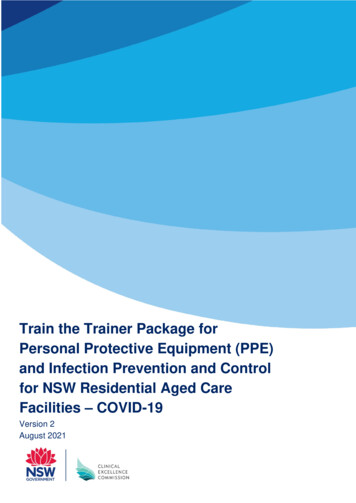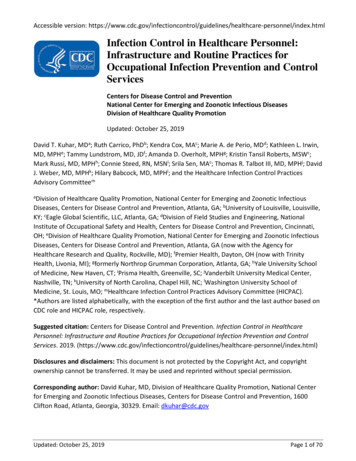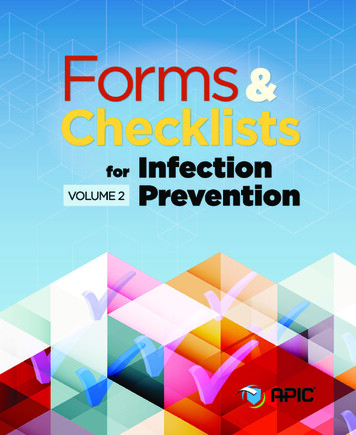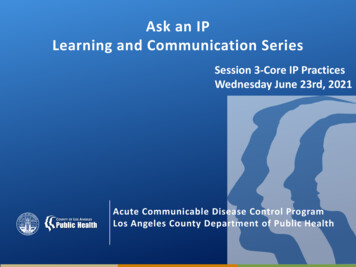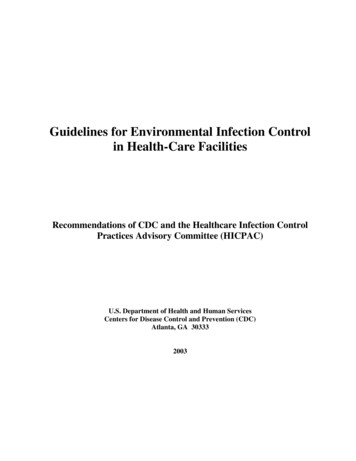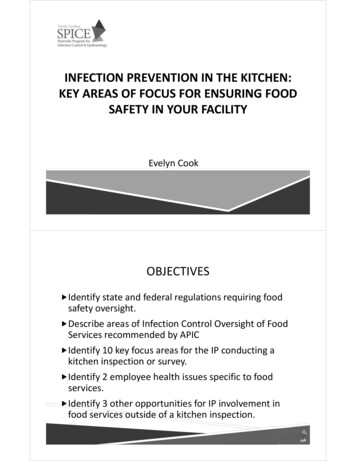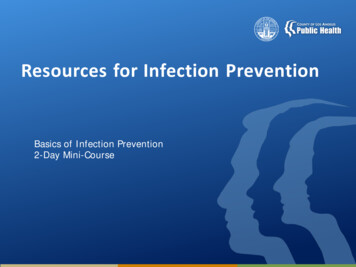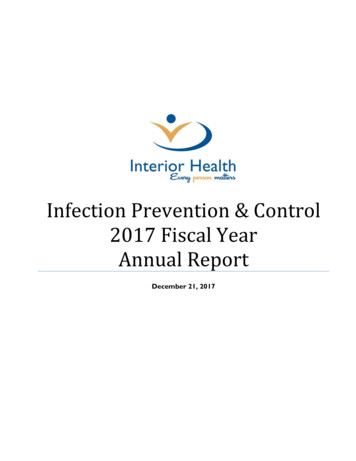
Transcription
Infection Prevention & Control2017 Fiscal YearAnnual ReportDecember 21, 2017
EXECUTIVE SUMMARYThe Infection Prevention and Control (IPAC) program’s 2017 fiscal year (FY) Annual Report,highlights the achievements and continued challenges facing infection prevention and controlpractices in Interior Health (IH). This report summarizes the progress of programs, theannual infection rates, and outlines the future strategic plans for the coming years.Highlights in program development during FY 2017 include: Slight decrease in Clostridium difficile infection (CDI) rate to 4.3/10,000 patient-days, andsignificant decreasing trend from FY 2013 through FY 2017o CDI rates for this year at Royal Inland Hospital (RIH), Vernon Jubilee Hospital (VJH),and Cariboo Memorial Hospital were below the IH CDI benchmark.The methicillin-resistant Staphylococcus aureus (MRSA) rates at most acute care facilitiesacross IH were below the IH MRSA benchmarko MRSA cluster investigation in one unit at Kelowna General Hospital (KGH) endedfollowing infection prevention improvements using a Lean 5S strategy, resulting in asubstantial decrease in frequency of MRSA.Surgical site infection (SSI) rates in clean and clean-contaminated surgery at RIH and VJHwere below the IH SSI benchmark.o SSI investigations followed observations of increased SSI frequency at KGH andPenticton Regional Hospital within specific surgery categoriesHand hygiene compliance rates in acute and residential care have strived to meet theprovincial target of 80% and rates are posted in all sitesSeveral large scale construction and renovation projects have received ongoing IPACguidanceo Construction permits are being developed electronically to assist in documentationof projectsIncreased number of RI outbreaks throughout Interior Health and the province resulting inextended length of duration of the outbreaks and increased attack rateso Collaborative work with the Communicable Disease Unit and senior leadership willbe targeted to improve outbreak management processesOngoing educational initiatives include:o Emerging Pathogens Training ongoing with new trainer education and yearlyrefresher trainingo Certification in Infection Control education for Infection Control Practitioners (ICPs)writing their initial certification or recertifyingo Development and implementation of provincial Additional Precautions signageo Development of provincial IPAC education modules for implementation in 2017/18It is anticipated that increasing collaboration with stakeholders will address IPAC issuesmore efficiently and effectively, while ensuring the highest quality of care for patients.2016-2017 Infection Prevention & Control Annual Report
TABLE OF CONTENTSINTRODUCTION . 1MEMBERS OF TEAM AND FACILITIES . 2GLOSSARY OF ACRONYMS AND TERMS . 0FISCAL YEAR 2017 STRATEGIC PLAN ACCOMPLISHMENTS. 2EDUCATION . 3HAND HYGIENE PROGRAM . 5LINK NURSE PROGRAM . 11CONSTRUCTION . 11EMERGING PATHOGENS . 12COMMUNICATION AND PROMOTION . 13SURVEILLANCE . 14ACUTE CARE FACILITIES . 15CLOSTRIDIUM DIFFICILE INFECTION . 15METHICILLIN-RESISTANT STAPHYLOCOCCUS AUREUS . 20VANCOMYCIN-RESISTANT ENTEROCOCCUS . 25CARBAPENEMASE-PRODUCING ORGANISMS . 26SURGICAL SITE INFECTIONS . 27VENTILATOR ASSOCIATED PNEUMONIA AND CENTRAL LINE ASSOCIATEDBLOODSTREAM INFECTION . 33RESIDENTIAL CARE FACILITIES. 34OUTBREAK SURVEILLANCE AND MANAGEMENT . 36FISCAL YEAR 2018 STRATEGIC PLAN . 39APPENDICES . iAPPENDIX A: STRATEGIC PLAN FISCAL YEAR 2017 . iAPPENDIX B: COMMUNICATIONS ACTION PLAN AND TIMELINE . iAPPENDIX C: HEALTHCARE ASSOCIATED INFECTION CASE DEFINITIONS . iv2016-2017 Infection Prevention & Control Annual Report
APPENDIX D: HAND HYGIENE COMPLIANCE BY FACILITY . viiAPPENDIX E: HEALTHCARE ASSOCIATED INFECTION RATES . ix2016-2017 Infection Prevention & Control Annual Report
INTRODUCTIONInfection Prevention and Control (IPAC) is a corporate program under the administrativedirection of the Vice President, Medicine and Quality. The overarching goal of IPAC is toprevent infections from occurring in patients, residents, clients, visitors, volunteers,physicians, and employees. Several strategies that have been implemented to achieve thisgoal are summarized in this annual report.The Infection Measurement Prevention and Control Team (IMPACT) reports to the HealthAuthority Medical Advisory Committee (HAMAC) and through the Senior Executive Team(SET) to the Board Quality Care Committee. IPAC has a standing time on the HealthAuthority Medical Advisory Committee agenda at which the Medical Director of IPACreports in person or by written report. The Vice President, Medicine/Quality reports toSET as required. The minutes of the IMPACT meetings are sent to the Board, andpresentations on various infection control strategies and issues are made to thesecommittees as scheduled throughout the year. IPAC liaises across the continuum with otherprograms such as Communicable Disease (CD) and Workplace Health & Safety regardingcommunicable diseases and outbreak management. In addition, there is an extensivenetwork of committees responsible for IPAC across the health authority.The IPAC program functions in accordance with international, national and provincialguidelines and best practices across the continuum of care. The IPAC program influencespractice through direct actions by managing infection surveillance and disseminating data toappropriate stakeholders. IPAC also develops and recommends policies, procedures andbest practices including, but not limited to, routine practices, additional precautions, asepsis,equipment cleaning, disinfection and sterilization, product selection and evaluation, andconstruction consultation as it pertains to IPAC. Education and training of healthcareproviders (HCPs), patients, and nonmedical caregivers is also an important part of the IPACprogram.2016-2017 Infection Prevention & Control Annual ReportPage 1
MEMBERS OF TEAM AND FACILITIESVice President, Medicine/ QualityDr. Alan StewartProject Lead, IPACJoy PyettCorporate Director, IPACJanice de HeerAdministrative Assistant, IPACConnie BergenCorrie CardonManager, IPACMarijke HenkemansSurveillance Information Assistant, IPACJason WiensMedical Director, IPACDr. Bing WangCo-op Student, IPACCourtenay PearceCharlie WhiteGabriel RamirezJessica GrewalEpidemiologist, IPACDr. Julie MoriEducator, IPACNicki GillInfection Control Practitioners:Missy BlackburnDebbie Cosgrove-SwanKelly DillonSandie McKechnieKrystal FergusWendy HerringtonMarion KabatoffEileen LavoieLynden LehmanMaureen McLean YoungLorena McLureAndrea NeilEvelyn NicolSuzanne HydermanRoberta BarronColeen ReiswigLisa SchwartzKaren StoopnikoffJoanne TenchAcute Care Hospitals:Cariboo MemorialEast Kootenay RegionalKelowna GeneralKootenay Boundary RegionalKootenay LakePenticton RegionalRoyal InlandShuswap Lake GeneralVernon JubileeRural Acute Care Facilities ( 20 beds):100 Mile DistrictElk ValleyArrow LakesGolden and DistrictBoundary DistrictInvermere and DistrictCreston ValleyLillooetDr. Helmcken MemorialNicola ValleyResidential/Long Term Care Facilities:Bastion PlaceHenry M. Durand ManorBrookhaven Care CentreJackson HouseColumbia HouseKimberley Special Care HomeColumbia View LodgeMcKinney Place Extended CareCottonwoods Care CentreMinto HouseDavid Lloyd Jones HomeMountain View LodgeDeni HouseMt. Cartier Court CottagesDr. Andrew PavilionNelson Jubilee ManorDr. F. W. Green Memorial HomeNoric HouseFischer Place/Mill Site LodgeOrchard HavenForest View PlaceOverlander Residential CareGateby Care CentreParkview PlaceGillis HousePleasant Valley ManorHardy View LodgePolson Special Care Unit2016-2017 Infection Prevention & Control Annual ReportPrinceton GeneralQueen VictoriaSouth Okanagan GeneralPonderosa LodgePoplar Ridge PavilionRidgewood LodgeSlocan Community Health CentreSpintlum LodgeSunnybank Retirement CentreSwan Valley LodgeTalarico PlaceThree Links ManorTrinity Care CentreVictorian HospitalWest View PlacePage 2
GLOSSARY OF ACRONYMS AND TERMSABHRAcute CareFacilityAlert levelALHAROBDHBenchmarkCACAUTICD NMRSANVHAlcohol-based hand rubCare facilities in which patients are treated for brief but severe episodes ofillness, for traumas and injuries, or recovery from surgeryA pre-determined facility-specific threshold [(i.e.) number of infections]within a specified time period that identifies a high transmissionpotential and triggers actions to be takenArrow Lakes HospitalAntibiotic Resistant OrganismBoundary District HospitalA point of reference for judging value, quality, change, or standard towhich others can be comparedCommunity AssociatedCatheter-associated urinary-tract infectionCommunicable Disease UnitClostridium difficile InfectionCertified in Infection ControlCentral Line Associated Bloodstream InfectionCariboo Memorial HospitalCarbapenemase Producing OrganismCreston Valley HospitalDr. Helmcken Memorial HospitalEast Kootenay HospitalEbola Virus DiseaseElk Valley HospitalFiscal YearGolden District HospitalGastrointestinal IllnessHealthcare AssociatedHealthcare Associated InfectionHealthcare ProviderHand HygieneInfection Control PractitionerIntensive Care UnitInvermere District HospitalInterior HealthInterior Health online education platformInfection Prevention and ControlKootenay Boundary Regional HospitalKelowna General HospitalKootenay Lake HospitalLillooet HospitalLimits or restrictionsLink NurseMethicillin-resistant Staphylococcus aureusNicola Valley Hospital2016-2017 Infection Prevention & Control Annual ReportPage 0
VREWorking group100 Mile House HospitalPrinceton General HospitalProvincial Infection Control Network of British ColumbiaPersonal Protective EquipmentPenticton Regional HospitalQueen Victoria HospitalRespiratory IllnessRoyal Inland HospitalRegistered NurseShuswap Lake General HospitalSouth Okanagan General HospitalSurgical Site InfectionTuberculosisGeneral movement or direction of change.Ventilator Associated PneumoniaVernon Jubilee HospitalVancomycin Resistant EnterococciA group of stakeholders working together to achieve a specified goalwithin a finite timeline2016-2017 Infection Prevention & Control Annual Report1 Page
FISCAL YEAR 2017 STRATEGIC PLAN ACCOMPLISHMENTSFive main strategies were identified for the FY 2017 with plans extending to the FY 2019(Appendix A). These strategic initiatives support the IPAC program and were specificallyaimed at addressing current and emerging issues.CLOSTRIDIUM DIFFICILE INFECTIONThe strategic initiative that focused on promoting a Zero Tolerance Program for all CDIs inthe health authority continued into FY 2017. IPAC collaborated with stakeholders toimprove the management of CDI across departments and facilities.The Best Practice Checklist for Management of CDI continues to be used by ICPs to helpidentify gaps in best practice for all admitted patients and residents with known or suspectCDI. Education action plans developed by ICPs target units/facilities with CDI rates overbenchmark.Refer to Actions Implemented for more information on CDI in acute facilities.HAND HYGIENEThe HH program saw additional efforts directed to all areas of the program includingeducation, auditing processes, and overall awareness. The HH program lead presented to the Hospital and Community Integration Services(HCIS). Leaders were asked by the vice-president HCIS to ensure HH rates areshared regularly with staff.Physician HH rates provided at quarterly Regional Medical Advisory Committeemeetings.Continually having two co-op students performing HH auditsA new ‘Hand Hygiene for Healthcare Workers’ pamphlet was developed andpublished.Two patient representatives continue to be valuable members of theinterdisciplinary HH working group.Refer to HH Program section Accomplishments/Priorities Met, for more information.COMMUNITY PROGRAMSThe IPAC team met to discuss the role of the ICP in the community setting. The followingpriority areas identified in FY 2016 were completed: Staff education is being delivered.Consultations are being done.2016-2017 Infection Prevention & Control Annual Report2 Page
IPAC practice assessment for wound care clinics has been developed.HAI SURVEILLANCEUnit-level surveillance processes have been developed and trialed on the electronic surveillancedatabase. Action plans were created and implemented by ICPs and facility staff where needed.Residential care HAI surveillance was conducted using prevalence surveys every two months.EDUCATION/ACCREDITATIONA standing item was added to IPAC meetings for an ICP to provide updates on Accreditation.IPAC education was provided to ICPs at monthly IPAC meetings and at face-to-face meetings.The Provincial Additional Precaution signs were rolled out: Educational boards regarding new signs were created and distributed across IH.ICPs educated staff and physicians across IH.Updates were made to guidelines and educational materials.Ongoing communication was provided to IH leadership and staff regarding the roll-outprocess.Refer to Education section Accomplishments/Priorities Met, for more information Programsand InitiativesEDUCATIONAn integral part of the IPAC program is the ongoing education, training, and support by ICPsto all HCPs, volunteers, and nursing and medical students within IH.ACCOMPLISHMENTS/PRIORITIES METHCPs were educated on various IPAC topics (Table 1). Education highpoints within theIPAC program included: Refresher Training for Emerging Pathogens commenced in January 2017Respiratory illness (RI) outbreak guidelines were updated and education to stakeholderswas provided in collaboration with the CD Unit.IPAC Manual:o New guidelines were developed for pertussis and respiratory viruseso Updates were made to the ARO guidelines, TB screening and AdditionalPrecautions guidelines with new signage2016-2017 Infection Prevention & Control Annual Report3 Page
o ‘Prevention & Control of Catheter Associated Urinary Tract Infections(CAUTI)’ guidelines were removed. Information now available in the “UrinaryCatheter in Adults” toolkito Microbiology guidelines were removed. Information now available on theMicrobiology Guide to Specimen Collection and Transport guideline.Four issues of Infection Reflections released (a quarterly publication that shares informationand updates on the latest IPAC issues)Three ICPs recertified their Certification in Infection Control (CIC)IPAC members attended two two-day education meetings in KelownaFour ICPs attended the PICNet Annual Education ConferenceOngoing educational sessions attended by ICPs:o Webber Trainingo Grand Roundso Public Health RoundsTable 1: Count of Education Provided by IPACEducation topicsHand HygieneCDI*Routine Practices/Additional Precautions/PPE*Outbreaks* (GI and/or RI)TuberculosisMiscellaneous* (including: orientation, updates to manual/ guidelines, skillfairs, risk assessments, isolation, housekeeping, construction, and AROs)Hand Hygiene for Healthcare Workers, IH i-Learn courseHand Hygiene for Medical Staff, IH i-Learn courseEmerging Pathogens, IH i-Learn courseEmerging Pathogens Initial Training, IH i-Learn courseEmerging Pathogens Refresher Training, IH i-Learn courseNumber ofHCPs 103*These topics include additional HH componentsGOING FORWARDIPAC educational materials are evaluated and revised annually. These materials are readilyavailable to ICPs and HCPs online (IH InsideNet) and are standardized across the healthauthority.The development of Provincial IPAC education modules is underway and includes RoutinePractices, Point of Care Risk Assessment, Personal Protective Equipment (PPE) and AdditionalPrecautions. These modules will be designed for clinical and non-clinical staff. Modules will befinalized within the next fiscal year. The plan is that these IPAC education modules will be made2016-2017 Infection Prevention & Control Annual Report4 Page
available on the i-Learn platform, will be part of all new staff orientation and will be arequirement for all current clinical and non-clinical staff to review.HAND HYGIENE PROGRAMThe main goals of the HH program include: Reducing the occurrence of HAIs by improving HH compliance Improving patient safety Meeting Provincial and Accreditation Canada requirements Educating HCPs, patients, and visitors about the importance of practicing optimal HH Supporting facilities in making the delivery of healthcare safer for everyoneThe key program components include a variety of ongoing education modules, includingbasic orientation, promotional material, and HH auditing.ACCOMPLISHMENTS/PRIORITIES METThe IH HH compliance rate met the provincial performance target of 80% in two quarters.Refer to Results for more information on all HH audit results.Since the HH program began hiring auditor co-op students, the program has had six HHauditor co-op students. The hiring has now been staggered to allow one senior student tomentor the in-coming student. Both are eight-month terms. Student auditors continued toenable the program to increase total numbers of observations. The students updated the coop student orientation package.The data from the completed Best Practices for Hand Hygiene Facilities & Infrastructure inHealthcare Settings: Facilities & Infrastructure Checklists for all IH acute and residential facilitieswere compiled. The infrastructure audit information was compiled and results shared with theCorporate Director.The FY 2017 HH rates for individual facilities will be publicly posted at all IH residentialfacilities.The Interior Health Hand Hygiene Working Group met quarterly to discuss and makerecommendations on various HH topics. This multidisciplinary group revised the ‘Gloves, HandHygiene, and You’ module and the ‘Hand Hygiene for Healthcare Worker’ pamphlet. Thegroup also developed a new education module, titled ‘Hand Hygiene in the Operating Room’.GOING FORWARDActions will be directed at continual improvement of HH compliance rates.2016-2017 Infection Prevention & Control Annual Report5 Page
The new education module ‘Hand Hygiene in the Operating Room’ will be promoted by theICPs for the six months following its release in April 2016.An East Kootenay Regional Hospital physician HH pilot project will provide in-the-momentfeedback to physicians for missed HH opportunities noticed during auditing.RESULTSThe annual HH compliance increased again this year across IH (Figure 1). The FY 2017 HHcompliance for IH was 79% (95% confidence interval {CI}, 78% - 79%), which was not asignificant increase compared to FY 2016. While compliance increased from year to year atmost facilities, no changes were statistically significant.Nursing staff make up the vast majority of HH observations in acute care (74% of allobservations) and their rate reached 80% this year. The group labeled “Other Staff”, which arelargely housekeeping staff, had the highest compliance of all healthcare worker groups (Figure2). Compliance among physicians was the same as last year.Over the past two years, the overall HH compliance rate has been fluctuating around 80%(Figure 3, top panel). Maintaining a rate above 80% has been a challenge. Typically there is adifference between HH compliance observed before and after contact with the patientenvironment, with compliance usually higher after contact. The difference narrowed in the lasttwo quarters of this year (Figure 3, bottom panel). The improvement in HH compliance beforepatient contact is encouraging.The HH compliance rate in IH residential care facilities did reach 80% in the last quarter of thisyear (Figure 4). For the year, the IH residential care HH compliance rate was 77% (95% CI,76% - 78%). There has been no change over the past year (Figure 4).It is important not to compare groups due to individual differences in sample sizes (number ofobservations), patient care needs, and other characteristics that are unique to each group. Ithas been recognized that ‘being observed’ in practice, e.g. during auditing, can lead to falselyelevated compliance rates. To minimize this effect, audits are completed in twenty to thirty(20-30) minute intervals (acute care) with no greater than six (6) observations made of thesame HCP within this period. In an effort to maintain consistency in audit practices, HH auditsare currently only observed by ICPs and co-op students.2016-2017 Infection Prevention & Control Annual Report6 Page
Figure 1. HH compliance rate (%) by fiscal year for IH and tertiary, service area, community, and smaller facilities.IHKGHRIHGradual, consistent progresshas continued.Compliance decreasedslightly this year.Good performancecontinued this year.100806974757879717575787674678081716040202013 2014 2015 2016 20172013 2014 2015 2016 2017VJHPRHEKHSteady improvement overthe past 5 years.Compliance increasedslightly this year.Good improvementcontinued this year.1001008580602013 2014 2015 2016 201764707276797280747176606668697276404020202013 2014 2015 2016 20172013 2014 2015 2016 20172013 2014 2015 2016 2017KBHCMHKLHDecrease in compliance thisyear.Very strong improvement incompliance this year.Another year of 6040202013 2014 2015 2016 20172013 2014 2015 2016 20172016-2017 Infection Prevention & Control Annual Report2013 2014 2015 2016 20177 Page
SLHSmaller facilities*Another year of strongimprovementCompliance improvementthis year10080737479848769757676786040202013 2014 2015 2016 20172013 2014 2015 2016 2017* Includes 100 Mile Hospital, Arrow Lakes Hospital, Boundary District Hospital, Creston Valley Hospital, Dr. HelmckenMemorial Hospital, Elk Valley Hospital, Golden District Hospital, Invermere and District Hospital, Lillooet Hospital, NicolaValley Hospital, Princeton General Hospital, Queen Victoria Hospital, South Okanagan General Hospital.2016-2017 Infection Prevention & Control Annual Report8 Page
Figure 2. HH compliance rates (%) by fiscal year for IH by healthcare provider group*, FY 2013 through FY2017NursesClinical SupportCompliance reached 80% this year.Compliance dropped this her StaffGood improvement in compliance this year.Compliance was 0142015201620172013*Clinical Support Staff: Occupational Therapist, Physiotherapist, Respiratory Therapist, Speech Therapist, Social Work,Dietician, Psychologist, Audiologist, Porter, Pastoral Care, Radiology, Technicians (e.g. EKG, EEG, etc.), Laboratory:Phlebotomy; Nursing: Registered Nurse, Registered Psychiatric Nurse, Midwife, Licenced Practical Nurse, Care Aide,Nursing/ Midwife Student; Other: Housekeeping, Food Services, Clerk, Volunteer, Security, Plant Maintenance; Physicians:Medical Doctor, Resident, Fellow, Medical Student2016-2017 Infection Prevention & Control Annual Report9 Page
Figure 3. HH compliance rates (%) in all IH acute care facilities by fiscal quarterHand hygiene compliance in IH acute care has met or exceeded theprovincial target of 80% several times in the past two 202015320162017Hand hygiene compliance in IH acute care observed before and aftercontact with patient environment became closer this 7 Infection Prevention & Control Annual Report41234201710 P a g e
Figure 4. HH compliance rates (%) in all IH residential care facilities by fiscal quarterHand hygiene compliance in IH residential care facilities met the provincialtarget of 80% in the last quarter of this 12015201642017LINK NURSE PROGRAMThe IPAC Link Nurse (LN) program continues at Royal Inland Hospital. The LN programwas designed to increase IPAC resources for staff in clinical areas by training volunteernursing staff to promote patient safety and collaborate with ICPs within their facility. Theprogram sought to have two IPAC LNs on each unit, working to increase awareness of IPACissues in their area and motivate staff to improve practice. The LNs are provided withspecialized education sessions designed to enable them to cascade information back to theircolleagues.ACCOMPLISHMENTS/PRIORITIES METThere was one education session for 12 LNs at Royal Inland Hospital. Comments providedby participants following each education session help direct development of educationalmodules for additional training sessions.GOING FORWARDThe LN Program will continue at Royal Inland Hospital.CONSTRUCTIONConstruction projects, in particular renovation projects, pose potential health risks forpatients, staff, visitors, and construction personnel that may lead to HAIs. These risks mostcommonly develop when dust particles contaminated with bacteria and fungi are dispersed2016-2017 Infection Prevention & Control Annual Report11 P a g e
into adjacent patient care areas. The primary fungus associated with these infections isAspergillus, while the major bacterium is Legionella.Early planning in construction and renovation projects must integrate IPAC, engineeringservices, and building design to prevent HAIs, and minimize allergen load and otherworkplace hazards. An IPAC Risk Assessment is required before construction or renovationbegins. To facilitate the risk assessment, Facilities Management and/or Capital Planning andProjects inform IPAC regarding the location of all areas requiring renovation andconstruction and an ICP will be involved in this planning process.ACCOMPLISHMENTS/PRIORITIES METIPAC provides vital education to contractors and staff on infection prevention practicesrelated to construction. Over 400 new construction and renovation permits were issued byICPs across IH during FY 2017. Of these issued permits, construction and renovationprojects ranged in size, completion time, and health risk.Some of the more significant projects included: Construction of the new Patient Care Tower at Penticton Regional HospitalCompletion of the new Clinical Services Building at Royal Inland HospitalPlanning for the construction of the new patient tower at Royal Inland HospitalCompletion of Intensive Care Unit renovation at Kootenay Boundary Regional HospitalCompletion of the new Intensive Care Unit at East Kootenay Regional HospitalGOING FORWARDA complete revision of the IPAC Construction Guidelines, including electronic permits, iscurrently ongoing.EMERGING PATHOGENSSince March 2014, West Africa has experienced the largest outbreak of Ebola in history, withmultiple countries affected. While the probability of Ebola virus disease (EVD) in InteriorHealth remains low, preparedness to ensure HCPs can safely and effectively care for patientshas remained an essential component of the IPAC program.ACCOMPLISHMENTS/PRIORITIES METEmerging Pathogens and Pandemic Planning Committee (EPPPC) is responsible for all aspects ofEbola preparedness in IH and has representation on provincial Ebola preparedness committees.2016-2017 Infection Prevention & Control Annual Report12 P a g e
In January 2017, the Refresher Training for Emerging Pathogens commenced using the IH iLearn platform, which p
The IPAC program functions in accordance with international, national and provincial guidelines and best practices across the continuum of care. The IPAC program influences practice through direct actions by managing infection surveillance and disseminating data to appropriate stakeholders. IPAC also develops and recommends policies, procedures and
